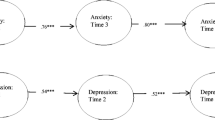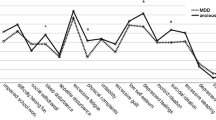Abstract
The relationship between anxiety and depression was examined in a sample of 106 children and adolescents referred to an outpatient anxiety disorder clinic for children. Twenty-eight percent of patients with DSM-III diagnoses of anxiety disorders displayed a concurrent major depression. Children with anxiety disorders plus major depression were found (1) to be older, (2) to demonstrate more severe anxiety symptomatology, and (3) to be diagnosed with different rates of certain anxiety-disorder subtypes, when compared to anxious patients without major depression. Nondepressed anxious children and adolescents did not differ from a psychopathological control group in severity of either anxiety or depression symptoms.
Similar content being viewed by others
References
Akiskal, H. S., & McKinney, W. T. (1975). Overview of recent research in depression: Integration of ten conceptual models into a comprehensive clinical frame.Archives of General Psychiatry, 32, 285–305.
Baker, H., & Wills, U. (1978). School phobia: Classification and treatment.British Journal of Psychiatry, 132, 492–499.
Beck, A. T. (1967).Depression: Clinical, experimental, and theoretical aspects. New York: Harper & Row.
Bernstein, G. A., & Garfinkel, B. D. (1986). School phobia: The overlap of affective and anxiety disorders.Journal of the American Academy of Child Psychiatry, 25, 235–241.
Breier, A., Charney, D., & Heninger, G. (1984). Major depression in patients with agoraphobia and panic disorder.Archives of General Psychiatry, 41, 1129–1135.
Davidson, S. (1961). School phobia as a manifestation of family disturbance: Its structure and treatment.Journal of Child Psychology and Psychiatry, 1, 270–287.
Gurney, C., Roth, M., Garside, R. F., & Kerr, T. A. (1972). Studies in the classification of affective disorders: The relationship between anxiety states and depressive illness.British Journal of Psychiatry, 121, 162–166.
Hershberg, S. G., Carlson, G. A., Cantwell, D. P., & Strober, M. (1982). Anxiety and depressive disorders in psychiatrically disturbed children.Journal of Clinical Psychiatry, 43, 358–361.
Hollingshead, A. B. (1975).Four-factor index of social status. Unpublished manuscript.
Hummel, T. J., & Sligo, J. R. (1971). Empirical comparison of univariate and multivariate analyses of variance procedures.Psychological Bulletin, 76, 49–57.
Jacobsen, R. H., Lahey, B. B., & Strauss, C. C. (1983). Correlates of depressed mood in normal children.Journal of Abnormal Child Psychology, 11, 29–40.
Kendell, R. E., & Discipio, W. J. (1970). Obsessional symptoms and obsessional personality traits in patients with depressive illness.Psychological Medicine, 1, 65–72.
Kolvin, I., Berney, P., & Bhate, R. (1984). Classification and diagnosis of depression in school phobia.British Journal of Psychiatry, 145, 347–357.
Kovacs, M. (1983a).The interview schedule for children (ISC): Form C, and the follow-up form. Unpublished manuscript, University of Pittsburgh.
Kovacs, M. (1983b).The interview schedule for children (ISC): Interrater and parent-child agreement. Unpublished manuscript, University of Pittsburgh.
Kovacs, M. (1983c).The Children's Depression Inventory: A self-rated depression scale for school-aged youngsters. Unpublished manuscript, University of Pittsburgh School of Medicine.
Last, C. G., Hersen, M., Kazdin, A. E., Finkelstein, R., & Strauss, C. C. (1987). Comparison of DSM-III separation anxiety and overanxious disorders: Demographic characteristics and patterns of comorbidity.Journal of the American Academy of Child Psychiatry, 26, 527–531.
Noyes, R., Clancy, J., Hoenk, P. R., & Slymen, D. J. (1980). The prognosis of anxiety neurosis.Archives of General Psychiatry, 37, 173–178.
Ollendick, T. H. (1983). Reliability and validity of the Revised Fear Survey Schedule for Children (FSSC-R).Behaviour Research and Therapy, 21, 685–692.
Puig-Antich, J. (1980). Affective disorders in childhood: A review and perspective.Psychiatric Clinics of North America, 3, 403–424.
Puig-Antich, J., Blau, S., Marx, N., Greenhill, L., & Chambers, W. J. (1978). Prepubertal major depressive disorder.Journal of the American Academy of Child Psychiatry, 17, 695–707.
Reynolds, C. R., & Richmond, B. O. (1978). What I think and feel: A revised measure of children's manifest anxiety.Journal of Abnormal Child Psychology, 6, 271–280.
Spielberger, C. (1973).Manual for the stait-trait anxiety inventory for children. Palo Alto: Consulting Psychologists Press.
Strauss, C. C., Forehand, R., Frame, C., & Smith, K. (1984). Characteristics of children with extreme scores on the Children's Depression Inventory.Journal of Clinical Child Psychology, 13, 227–231.
Waldron, S., Shrier, D. L., Stone, B., & Tobin, S. (1975). School phobia and other childhood neuroses: A systematic study of the children and their families.American Journal of Psychiatry, 132, 802–808.
Author information
Authors and Affiliations
Rights and permissions
About this article
Cite this article
Strauss, C.C., Last, C.G., Hersen, M. et al. Association between anxiety and depression in children and adolescents with anxiety disorders. J Abnorm Child Psychol 16, 57–68 (1988). https://doi.org/10.1007/BF00910500
Revised:
Issue Date:
DOI: https://doi.org/10.1007/BF00910500




